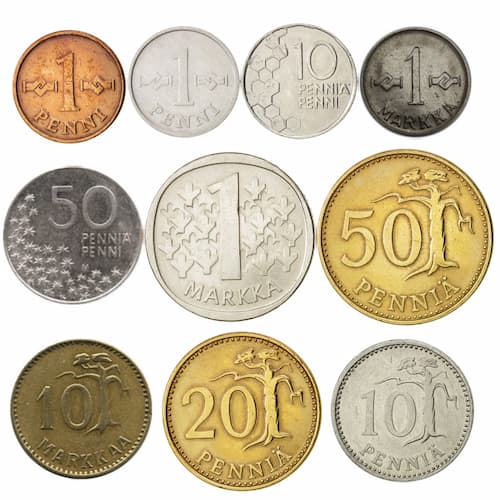Finland, a country known for its breathtaking natural beauty, innovative technology and rich cultural heritage, also has a fascinating monetary history. The evolution of the currency in Finland reflects its historical milestones, economic challenges and path towards European integration.
Whether you are a numismatist interested in the unique designs of ancient Finnish coins or a traveller planning your next Nordic adventure, understanding the history and practicalities of Finnish coinage will give you a better appreciation of this diverse and dynamic country.
Next, we delve into Finland’s ancient coins and catch up on the euro, the current currency, offering essential tips and insights for anyone planning to visit this extraordinary country.
Contenidos
The Markka era
Before adopting its own currency, Finland was part of the Swedish Kingdom and Swedish coins were used. Only after gaining autonomy in 1809 and becoming a Grand Duchy under the Russian Empire did Finland start to think about its own currency.
Introduction of the Finnish mark
The Markka or Finnish mark was introduced in 1860, replacing the Russian rouble at the rate of 4 marks to 1 rouble, as Finland sought to establish a strong economic identity.
The Finnish mark was subdivided into 100 penniä, with coins minted initially in silver and later, for smaller denominations, in bronze, nickel and finally aluminium.
Frame design and commemoration
The designs on Finnish coins of the mark era often celebrated the nation’s culture, history and landmarks. They featured prominent Finnish figures, such as the national poet Johan Ludvig Runeberg and the composer Jean Sibelius, and depicted symbols of Finnish nature and architecture.
Commemorative coins, in particular, reflected milestones in Finnish history and were collectors’ items due to their unique designs and limited mintages.

Transitional periods
The Finnish mark underwent several significant transformations, especially during and after the World Wars, which had an impact on its value and design.
Inflation and economic reforms led to the introduction of new series of banknotes and coins, and the Markka was revalued in 1963, with the introduction of the new mark (equal to 100 old marks). This period was marked by attempts to stabilise the Finnish economy and strengthen the international position of the currency.
The road to the euro
Finland’s path to adopting the euro began in earnest when it joined the European Union in 1995. This was seen as a natural step in Finland’s integration into the European community, with the aim of increasing economic stability and promoting growth.
Joining the eurozone required the fulfilment of strict economic and legal criteria, a goal that Finland achieved by focusing on fiscal discipline and economic reforms.
Adoption of the euro
On 1 January 2002, Finland officially adopted the euro, becoming one of the first of the new members to take this historic step.
The transition from the mark to the euro was smooth, with a period of dual circulation in which both currencies were accepted to ease the transition for both citizens and businesses.
The euro today
The euro (€) is the official currency of 19 of the 27 countries of the European Union, including Finland. It is one of the world’s most widely traded currencies and is seen as a symbol of economic unity and stability in Europe. There are coins in denominations of 1, 2, 5, 10, 20 and 50 cents, as well as 1 and 2 euro coins, and banknotes in denominations of 5, 10, 20, 50, 100, 200 and 500 euro.
Finnish euro coins feature unique designs on the national side, depicting Finnish figures, symbols and themes.
Using the euro in Finland: practical information for visitors
For those planning to visit Finland, it is useful to know that cash transactions are still common, although electronic card payments are widely accepted and often preferred.
ATMs are available in all cities and towns, and currency exchange services are offered at airports, railway stations and bureaux de change.
Here are some tips on how to manage your money during your trip to Finland:
- Cash or card: Although Finland is very card-friendly, it is advisable to have some cash for small purchases in remote areas or markets.
- ATM withdrawals: Use ATMs affiliated with reputable banks to avoid high transaction fees.
- Currency exchange: To get the best exchange rates, consider exchanging a small amount of currency before your arrival and use ATMs or card payments for the rest of your transactions.
In conclusion, the evolution of the currency from the Finnish mark to the Euro tells the story of Finland’s economic resilience, its adaptability and its place in the wider European community. The euro has facilitated travel and trade, further integrating Finland into the European fabric.
For visitors, the transition to the euro means comfort, but Finland’s rich history of ancient coins remains a fascinating chapter in the nation’s history. As you explore Finland, from its vibrant cities like Helsinki to the tranquil landscapes of Lapland, you will carry in your wallet not just a coin, but a piece of European history.
